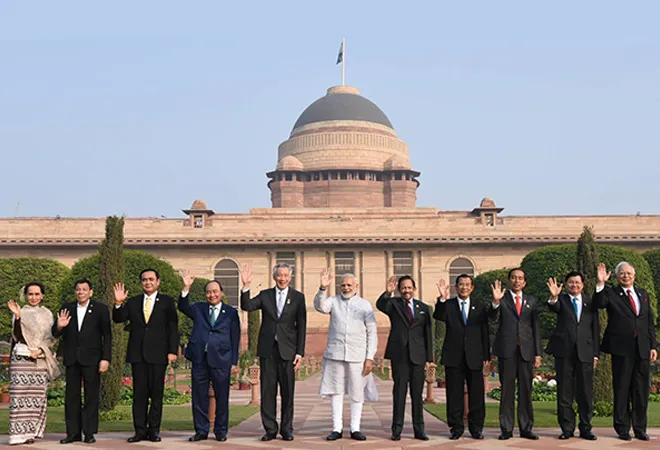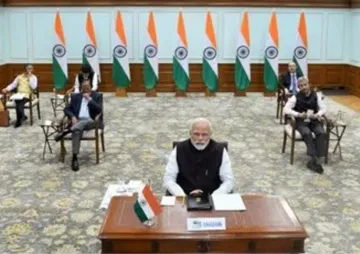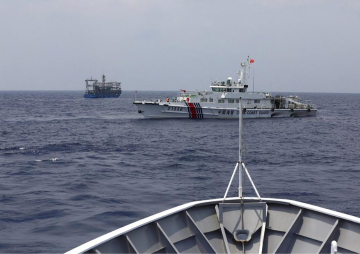
Introduction
India’s ‘Act East’ policy is a diplomatic initiative to promote economic, strategic and cultural relations with the vast Asia-Pacific region at different levels. The country’s eastward drive since 1992 has underscored the importance of this region in its contemporary international relations. ‘Act East’ and its early avatar, ‘Look East’ are not different; rather, they are two sides of the same coin, representing two different, but continuing phases in the evolution of India’s policy towards the Asia-Pacific region. When India launched the Look East policy in 1991, its own economic strength, its global status and the external environment were not what they are at present. At the time of its launch, India was struggling to transition from a state-controlled economic regime to a more liberalised one. It took many years for the country to get adjusted to the newly emerging economic environment. When in 2014, Prime Minister Narendra Modi launched the Act East policy, India’s economy was relatively robust and its global profile was higher than it was in the decades prior. Modi gave a new thrust to intensify economic, strategic and diplomatic relations with countries that share common concerns with India on China’s growing economic and military strength and its implications for the evolving regional order.<1>
The end of the Cold War in 1991 brought about a major shift in the economic and strategic policies of most countries in Asia; they were compelled to make suitable policy changes to cope with the changing economic and security situations in the region. India was no exception, and it made three significant changes in its policies. First, India’s adoption of economic reforms in the early 1990s was a major shift in its development strategy.
Second, as the Cold War thawed, India began adopting a multi-dimensional foreign policy that facilitated closer economic and strategic engagements with the United States (US). Their relations steadily warmed, leading eventually to the signing of the historic civil nuclear cooperation agreement in 2008.<2> Third, the launch in 1992 of the Look East policy was India’s response to the new challenges it faced in the region after the collapse of the Cold War structures. Although India’s relations particularly with Southeast Asian countries were old and historical, this advantage was not considered in the calculation of India’s policies towards the region.<3>
In the post-Cold War period, there was a strong rationale for India to cultivate closer relations with the countries of the region for mutual benefit. The Gulf War of 1990-91 severely affected the Indian economy owing to an unprecedented rise in oil prices. It was further accentuated by the fall of the Soviet bloc on which the Indian economy heavily depended. India was therefore compelled to seek alternative regions for its economic sustenance. Unfortunately, its own immediate neighbourhood, South Asia, did not offer many opportunities for trade and investment. Political bickering and lack of trust, and the economic backwardness of the region compelled India to look to Southeast and East Asia for greener pastures. China, having embarked on a modernisation programme was then well on its way to becoming a major player in the Indo-Pacific region. Japan, the second biggest economy of the world at that time, had already established its footprints in the ASEAN region by setting up its manufacturing bases there. Realising that ASEAN and East Asia offered immense prospects for growth, India launched its Look East policy.
While the initial motive was predominantly economic, Look East soon acquired strategic dimensions too. Over a period of time, as India forged partnerships with several countries in the region, their relations rested on three major pillars: Elaborate institutional mechanisms; economic interests including infrastructure development and connectivity; and common strategic interests.
Institutional support
An examination of India’s relations with ASEAN, Japan, South Korea, and now Australia would show how a vast network of institutional structures has lent support to expanding bilateral engagements. India joined the ASEAN in 1992 as a sectoral partner and became a full-fledged member in 1994. It is now an active member of the ASEAN Regional Forum (ARF), the East Asian Summit (EAS) and the ASEAN Defence Ministers Meeting Plus. Today there are 30 sectoral dialogue mechanisms and seven Ministerial-level interactions in addition to annual summit-level meetings.<4>
The same characteristic feature is seen in the case of both Japan and South Korea—two major pillars in India’s Act East policy. A vast array of institutional mechanisms binds their partnership in such forums like annual summit, strategic dialogue, defence dialogue, and numerous forums on energy cooperation, counter-terrorism, U.N. reforms, cyber security, and maritime cooperation. Further, India and Japan have institutionalised 2+2 Ministerial Dialogue.<5> PM Modi gave considerable importance to the need for extending the dialogue beyond the bilateral ambit, upgrading the trilateral US-Japan- India dialogue to ministerial level. Equally important is India’s participation in the quadrilateral meetings with the US, Japan and Australia, particularly since 2017 which has underlined New Delhi’s interest to exchange views on the strategic environment of the Indo-Pacific region. At the same time, however, India is cautious not to offend China in the process.
Similarly, both India and South Korea have forged several bilateral mechanisms to strengthen their partnership. A joint commission for bilateral cooperation at the level of foreign ministers has been regularly meeting since 1996, as well as a Foreign Policy and Security Dialogue at the secretary level. Moreover, the defence ministers and the national security advisers of both countries have been meeting regularly to promote their strategic cooperation. In early September 2019, India’s defence minister Rajnath Singh visited Seoul to participate in the bilateral defence dialogue.<6>
Growing economic relations
India’s economic relations with the countries of ASEAN have witnessed dramatic growth in recent years. India and the ASEAN have signed two trade agreements in goods and services, creating one of the biggest trade areas with a market of 1.8 billion people and a combined GDP of about US$3 trillion. India-ASEAN annual trade today accounts for more than US$80 billion for the first time in history, although the figure is still far below the target of US$200 billion set for 2020.<7> A good deal of ASEAN private investment has also flowed into India in many sectors including construction of ports, highways, food processing, shipping, and auto components. Similarly, India’s investments in ASEAN have grown considerably in recent years, with Singapore becoming its investment and trading hub.
One can see a similar pattern in India’s trade with Japan and South Korea. Though India and Japan entered into a comprehensive economic partnership agreement (CEPA) in 2011, the volume of bilateral trade has been decreasing. In 2014-15, trade between the two amounted to US$15.71 billion, and came down to US$14.51 billion in 2015-16. It further declined to US$13.60 billion in 2016-17, before it recovered to a record US$15.71 billion in 2017-18.<8>
Efforts are ongoing to review the terms of the CEPA to give a boost to bilateral trade. One can see the same phenomenon in the case of India-South Korea trade. Like Japan, South Korea also signed a free trade agreement with India in 2009, but did not find the bilateral trade growing as expected. Both countries since then have reviewed the working of the CEPA to augment the volume of trade.
The story regarding Japan’s and South Korea’s investments in India is different. Prime Minister Modi has shown great interest in acquiring Japanese investment for several infrastructure projects. Praising Japan for having done more for India’s modernisation than any other country, Modi believes that Japan’s technological and economic prowess can help accelerate India’s development by transforming its infrastructure and manufacturing sectors. In their first summit meeting in 2014, Modi and his Japanese counterpart, Shinzo Abe set the target of doubling Japan’s direct investment and the number of Japanese companies in India. Japan agreed to extend US$ 33.5 billion public and private investments in India. This amount would be used to support projects in various sectors including infrastructure, connectivity, transport, smart cities, energy and skill development.<9> Modi decided to set up a number of Japanese industrial townships and electronic parks in India. In turn, Abe agreed to support India’s ‘Make-in India’, ‘Digital India’ and ‘Skill India’ programmes.
The volume of Japanese private investment in India has increased since 2014 owing to the Indian government’s efforts, like the creation of a special Japan Plus desk at the Ministry of Commerce and Industry to minimise the bureaucratic obstacles in clearing investment projects. The value of Japan’s investment jumped from US$ 1.7 billion in 2014 to US$ 4.7 billion in 2016-17. The cumulative Japanese investment in India from April 2000 to December 2016 amounted to US$ 25.2 billion, accounting for eight percent of India’s total FDI during that period.<10> Japanese investment flowed into several important sectors including automobile, telecommunications, chemicals and pharmaceuticals.
Almost similar trends could be seen in India-South Korea economic engagements. They signed a CEPA in 2009 that helped the bilateral trade to increase to US$ 20.5 billion in 2011 though it dropped in the following years. Subsequently, bilateral trade recovered and jumped to US$ 21.5 billion in Both countries believe that the full potential of the bilateral trade has not been tapped so far and they have taken measures to review the CEPA and make corrective measures to boost trade. Both countries have set a target of reaching US$ 50 billion by 2030. Considering the potential, it appears to be an achievable goal.<11>
South Korean FDI to India has steadily increased in recent years, reaching US$ 5.71 billion by the end of 2018. Korea’s presence in the automobile sector has become prominent, with Hyundai Motors playing a key role. Hyundai has also started another plant recently to increase its market presence. South Korea has virtually taken over India’s electronics sector with Samsung and LG playing a prominent role. Hyundai, Samsung and LG have won the confidence of Indian consumers and have become household names across India.<12>
India’s Act East Policy is closely connected with its long-term vision of developing its Northeastern region (NER) which is considered as a gateway to Southeast Asia. Prime Minister Modi has shown a strong commitment to developing the infrastructure of the region in transport, highways, communication, power and waterways. Since Japan’s interests in the NER are deeply rooted in history, there is a broad bilateral consensus to cooperate for the development of the region. Several recent developments in India- Japan relations have underscored the increasing convergence of interests between the two, who will both stand to benefit by collaborating in the region. In the past, the interests of the NER did not receive as much attention as required from both the central and state governments and it hampered the development of the region which remained backward without infrastructure facilities. Further, local insurgencies, disorder and even external interference considerably came in the way of the region’s progress.
Prime Ministers Modi and Abe, in their first summit meeting in 2014, emphasised the importance of the NER. The Tokyo Declaration, which they released after that meeting, underscored Japan’s commitment to enhancing connectivity and development in the NER and stressed the need for linking the region with other economic corridors within India and Southeast Asia for the economic progress of the region.<13> At the next summit held in 2015, Abe expressed his intention to provide Japan’s official development assistance (ODA) loans for connectivity projects in the NER. In 2016, Japan reaffirmed its commitment to enhancing connectivity and expressed satisfaction at the progress of projects in the region.
Indo-Japanese cooperation received a big push with the two prime ministers signing an agreement in 2017 to establish the India-Japan Act East Forum which is conceived of as a platform for bilateral cooperation. The forum will identify projects for the economic advancement of the region, with focus on connectivity projects, disaster management and environment and people-to-people contacts through tourism and culture.<14> It was inaugurated in December 2017 and Japan has already extended a substantial ODA loan which would not only upgrade the National Highways (NH 40) but also support India’s connectivity initiatives in Bangladesh, Myanmar, and other neighbouring countries.
A look at Japan’s recent and ongoing projects in the Northeast would clearly show Tokyo’s deepening involvement not only in road network connectivity, but also in many other spheres including energy, water supply, health, irrigation, environment and people-to-people exchanges.
The connectivity projects in the NER will foster greater integration not only within the NER, but also externally with neighbouring countries. After all, it is in India’s Northeast where India’s Act East policy and Japan’s ‘Open and free Indo-Pacific strategy’ converge and both countries are keen to extend their cooperation to the broader Indo-Pacific region. This includes the African continent too. In May 2016, Modi announced a proposal to develop an Asia- Africa Growth Corridor (AAGC) with the support of Japan. It is a proposal for creating a “free and open Indo-Pacific region” by building a series of sea corridors that will connect with India and other countries of South and Southeast Asia. A major objective of the proposal is to bring about greater integration within the Indo-Pacific region by undertaking infrastructure projects.
It is significant to note that both India and Japan are already collaborating in projects in Sri Lanka (LNG related infrastructure), Myanmar (development efforts in the Rakhine state), Bangladesh (road and reconstruction of bridges) and in Kenya (health services). Both countries have had long engagement with the African continent which would be useful in promoting the goals of the AAGC. To be sure, they have a long way to go and it is still far-fetched to view the AAGC as a counter to China’s ambitious Belt and Road Initiative (BRI). In this context, it is also necessary to understand the somewhat differing approaches of India and Japan towards the BRI as well as the improving equations between China and Japan, and China and India.
Shared strategic interests
The Look East policy was first intended as an economic strategy to boost India’s trade and investment relations with the Southeast Asian region. Over the years, it not only expanded its geographical reach to include Japan, South Korea and Australia, but has also assumed significant strategic and political dimensions. With Modi’s adoption of the Act East policy, the strategic factor has assumed greater salience. India has now forged strategic partnerships with Indonesia, Vietnam, Malaysia, Japan, South Korea and Australia. In addition, it has also established close links with countries of the BIMSTEC group of countries and the IOR.
Prime Minister Modi has described India’s vision in the region in one word, SAGAR which stands for Security and Growth for All in the Region. Incidentally, sagar is Hindi for ‘ocean’. India’s strategic interests in the region are many. First and foremost, India is concerned about the strategic uncertainties in the region following the decline of US influence and the rapid rise of China. India, therefore, is interested in contributing along with other like-minded countries to the evolving new regional order which should be open, rules-based, and free from the influence of any single hegemon. In his address at the Shangri La Dialogue in June 2018, Modi underlined, “Such an order must believe in sovereignty and territorial integrity as well as equality of all nations, irrespective of size and strength. These rules and norms should be based on the consent of all, not on the power of the few. This must be based on faith in dialogue and not on dependence on force.<15> Second, as a country dependent on sea-borne trade for its sustenance, it recognises the inherent rights of all countries to freedom of navigation, overflight, and unimpeded commerce in open seas. Maritime security is an important aspect of India’s Act East policy.
Third, India also believes that no country should use force as a means of settling disputes. Fourth, India’s Act East policy supports connectivity programmes for promoting regional cooperation and integration. Unlike the Look East Policy, the present Act East lays great emphasis on the connectivity programmes that link India’s Northeast region with ASEAN countries. India’s Act East policy has a strong synergy with Japan’s Free and Open Indo-Pacific and South Korea’s New Southern Policy. All three recognise the centrality of the ASEAN region and their economic and strategic interests converge in the Indo-Pacific and provide a great opportunity for mutual cooperation.
In this context, South Korean President Moon’s efforts to deepen Seoul’s relations with India and ASEAN have great implications for the security and stability of the Indo-Pacific region. His visit to India in 2018 provided a strong stimulus to both countries to augment their engagements in multiple spheres including trade, investment, nuclear disarmament, defence, maritime security and energy cooperation. Moon’s emphasis on the centrality of the ASEAN resonates well with India’s interests in cultivating closer relations
with those countries. In particular, Vietnam’s rising profile in ROK’s New Southern Policy is something that India would welcome given its own deepening relations with Hanoi. It is important to note that Moon and Modi, in their joint vision statement of July 2018, agreed to explore tripartite partnership for development in third countries beginning with capacity- building in Afghanistan.<16> South Korea could reinforce the efforts of India and Japan which have already undertaken development projects in countries like Bangladesh, Myanmar, Kenya and Sri Lanka.
This essay originally appeared here
Endnotes
<1> See Thomas Lynch III and James J. Przystup, India-Japan-Strategic Cooperation and Implications for U.S. Strategy in the Indo-Asia-Pacific Region (Washington D.C.: Center for Strategic Research, Institute for National Strategic Studies, National Defence University, 2017), 10.
<2> See K.V. Kesavan, “India and Japan: Changing Dimensions of Partnership in the Post-cold War Period,” Occasional Paper 14, Observer Research Foundation, May 2010, 5–6.
<3> See Sudhir Devare, India and Southeast Asia: Towards Security Convergence (Singapore: Institute of Southeast Asian Studies, 2006), 1–10.
<4> Prabir De, “Shared Values, Common Destiny: What we expect from the 16th ASEAN-India Summit,” Economic Times, November 2018.
<5> See Joint Statement, First India-Japan Foreign and Defence Ministerial Meeting, Ministry of External Affairs, Government of India, 30 November 2019; Also see K.V. Kesavan, “India-Japan 2+2 meeting to set tone for Modi- Abe summit in Delhi,” Observer Research Foundation Raisina Debate, 29 November 2019.
<6> Tribune News Service, “India, South Korea sign defence agreement,” Tribune, 6 September 2019.
<7> Prabir De, op. cit.
<8> Japan–India Relations (Archives), Ministry of Foreign Affairs of Japan.
<9> “The Tokyo Declaration for India-Japan Special Strategic and Global Partnership,” Ministry of External Affairs, Government of India, 1 September 2014.
<10> “India–Japan Economic Relations,” Indian Embassy, Tokyo, 2019.
<11> Joint Statement by President Moon and Prime Minister Modi, “India and Republic of Korea: A Vision for people, prosperity, Peace and our Future,” Media Centre, Bilateral/Multilateral Documents, Ministry of External Affairs, Government of India, 10 July 2018.
<12> “India-ROK Trade and Economic Relations”, Embassy of India, Seoul, 20 May 2018.
<13> “The Tokyo Declaration for India-Japan Special Strategic and Global Partnership,” op. cit.
<14> “Launch of India-Japan Act East Forum,” Media Centre, Press Releases, Ministry of External Affairs, New Delhi, 5 December 2017.
<15> Prime Minister Modi’s Keynote Address at Shangri La Dialogue, Ministry of External Affairs, Government of India, New Delhi, 1 June 2018.
<16> Joint Statement by President Moon and Prime Minister Modi, op. cit.
The views expressed above belong to the author(s). ORF research and analyses now available on Telegram! Click here to access our curated content — blogs, longforms and interviews.




 PREV
PREV


